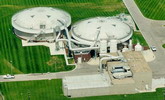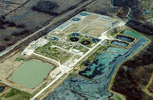
In the biological treatment of wastewaters, a mixed population of microorganisms utilizes the colloidal and dissolved organics found in the effluent from the primary treatment as their man food supply. In consuming these organics, the microorganisms utilize part of the organic substances to obtain the energy needed for their life activities. When the oxidation of organics occurs in the presence of dissolved oxygen the end products include carbon dioxide, water, sulfates, nitrates, and phosphates. The remainder part of the consumed organics are used as building blocks in a series of synthesis (reproduction) reactions that result in an increase population of microorganisms. Therefore, the colloidal and dissolved organics originally present in the wastewater have been transformed in part into a stable form, such as carbon dioxide, and part into a viable biological mass. This biochemical reaction is active in all biological treatment processes. The biological mass must subsequently be separated from the wastewater to ensure a proper degree of treatment within effluent and water quality standards. If this biological mass is not properly removed from the waste stream, usually by final clarification, effluent quality will be degraded and a higher BOD and S.S. load will be placed on the receiving waters.

In the activated sludge process the microorganisms are dispersed throughout the water phase. While in trickling filters or biodiscs the microorganisms are attached to a fixed surface forming a biological film. In either, the microorganisms are doing the treatment and therefore all precautions must be taken to assure a favorable environment for their life cycle.

